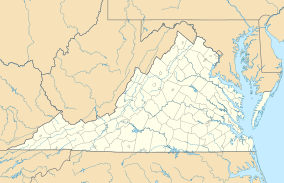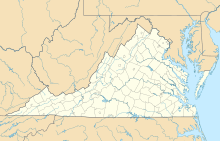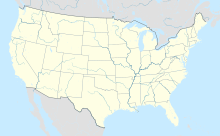Great Falls Park facts for kids
Quick facts for kids Great Falls Park |
|
|---|---|
|
IUCN Category V (Protected Landscape/Seascape)
|
|
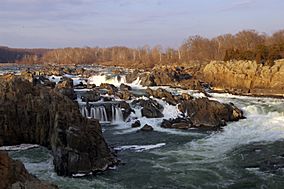 |
|
| Location | Fairfax County, Virginia, USA |
| Nearest city | McLean, Virginia |
| Area | 800 acres (320 ha) |
| Established | 1966 |
| Visitors | 645,000 (in 2002) |
| Governing body | National Park Service |
| Great Falls (climbing area) | |
|---|---|
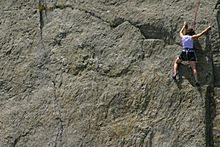 |
|
| Location | Fairfax County, Virginia, USA |
| Nearest city | McLean, Virginia |
| Coordinates | 38°59′20.87″N 77°14′51.52″W / 38.9891306°N 77.2476444°W |
| Climbing type | top-rope crag |
| Height | 35-50 feet |
| Pitches | 1 |
| Ratings | 5.0-5.12 |
| Grades | I |
| Rock type | Wissahikon Mica-schist with quartz crystals |
| Quantity of rock | days worth |
| Development | very well developed |
| Cliff aspect | East facing |
| Season | spring to fall |
| Ownership | National Park Service |
| Camping | none |
| Classic climbs |
|
Great Falls Park is a cool place managed by the National Park Service (NPS) in Virginia, United States. It covers about 800 acres (3.2 square kilometers) along the Potomac River. This park is part of the George Washington Memorial Parkway.
The park is famous for the amazing Great Falls of the Potomac River. These powerful waterfalls are a must-see! You can also find the remains of the Patowmack Canal here. This was the very first canal in the U.S. that used special "locks" to move boats up and down.
Contents
Exploring the Park's Past
Ancient History and Early Engineering
Long ago, Native Americans lived near these falls. They left behind special rock carvings called petroglyphs on cliffs overlooking Difficult Run.
Later, a big project called the Patowmack Canal was started. George Washington helped fund this canal. It was built to help small boats get around the powerful falls. This allowed goods to be moved more easily.
The canal started working in 1785. Workers used blasting powder to break through solid rock. This was one of the first times blasting powder was used for building projects anywhere!
A Canal's End and a Park's Beginning
The Patowmack Canal didn't make much money. Other ways to transport goods, like the Chesapeake and Ohio Canal and railroads, became more popular. So, the Patowmack Canal was stopped in 1830. Today, it's recognized as an important historical landmark.
You can still see the ruins of a small town called Matildaville, Virginia along the park trails. This town was built to support the canal workers.
From Amusement Park to National Park
For a while, from 1906 to 1932, there was even an amusement park at the falls! It was at the end of an electric trolley line that started in Georgetown, Washington, D.C.. The park had picnic areas, a dance hall, and a carousel. At night, a bright searchlight lit up the falls.
Today, the park still has picnic areas and a visitor center. Sadly, a big flood caused by Hurricane Agnes in 1972 destroyed the carousel.
In 1966, Great Falls Park became part of the National Park Service. This helped protect the area for everyone to enjoy. There was once an idea to build a bridge over the falls, but it was never built. People wanted to protect the river's natural beauty.
Visiting Great Falls Park
Getting to the Park
You can usually get to the park by driving on Georgetown Pike (Virginia Route 193) and Old Dominion Drive. Bigger roads nearby include the Capital Beltway (Interstate 495).
There's a $20 entrance fee per car. The park is open only during daylight hours. On busy weekends, the parking lots can fill up fast. Sometimes, the park might even close temporarily if it gets too crowded.
Things to See and Do
The park has several viewing spots where you can get amazing views of the waterfalls. The National Park Service also runs a visitor center near the falls. Here, you can learn more about the park's history and nature.
There are 15 miles (24 kilometers) of hiking trails in the park. Some trails follow a small stream called Difficult Run. A beautiful trail near the river goes upstream from Difficult Run. It climbs to the top of Mather Gorge and passes the falls. This trail continues past a dam and a reservoir, ending at Riverbend Park.
Rock Climbing and Water Fun
If you're into adventure, rock climbers often visit the cliffs in Mather Gorge. These cliffs are right above the Potomac River.
The falls drop a total of 76 feet (20 meters) in a series of big cascades. The Great Falls are known for their powerful whitewater. They are rated Class 5-6, which means they are very difficult and dangerous for boating.
Expert whitewater boaters have been kayaking the falls since the early 1990s. Below the falls, through Mather Gorge, the river is a bit calmer. It's rated Class 2-3, making it a popular spot for kayakers since the 1960s.
It's important to remember that going into the water above the falls from the Virginia side is against the law. This is for your safety because the currents are very strong and dangerous.
Images for kids


